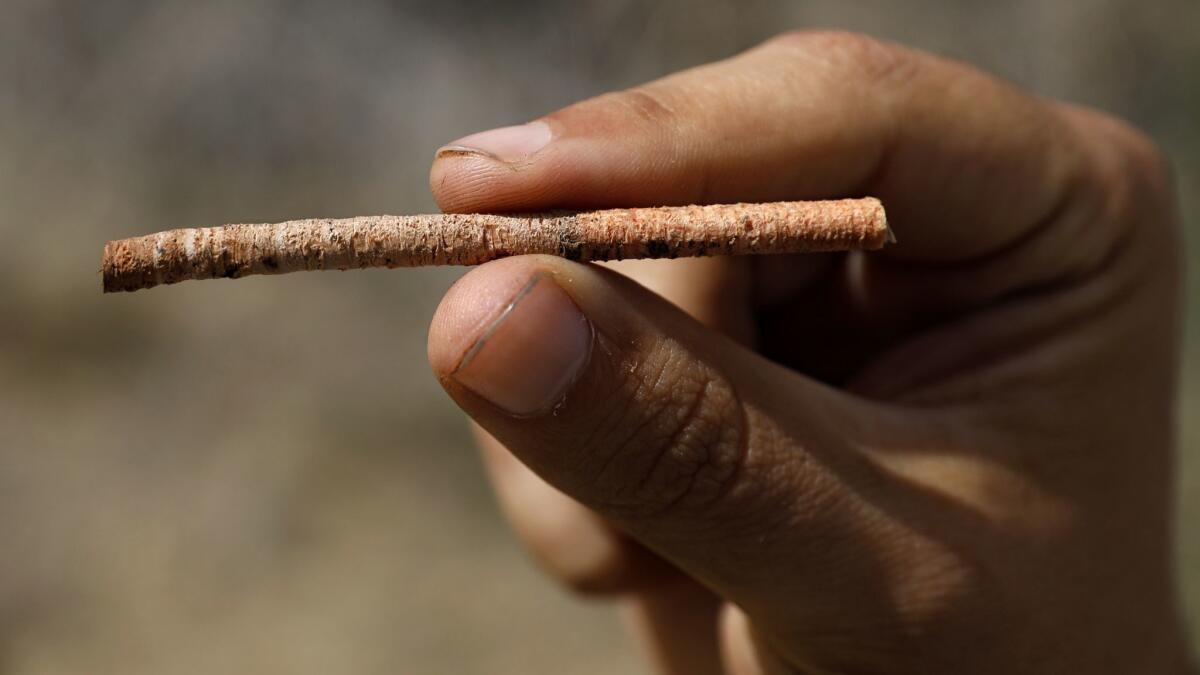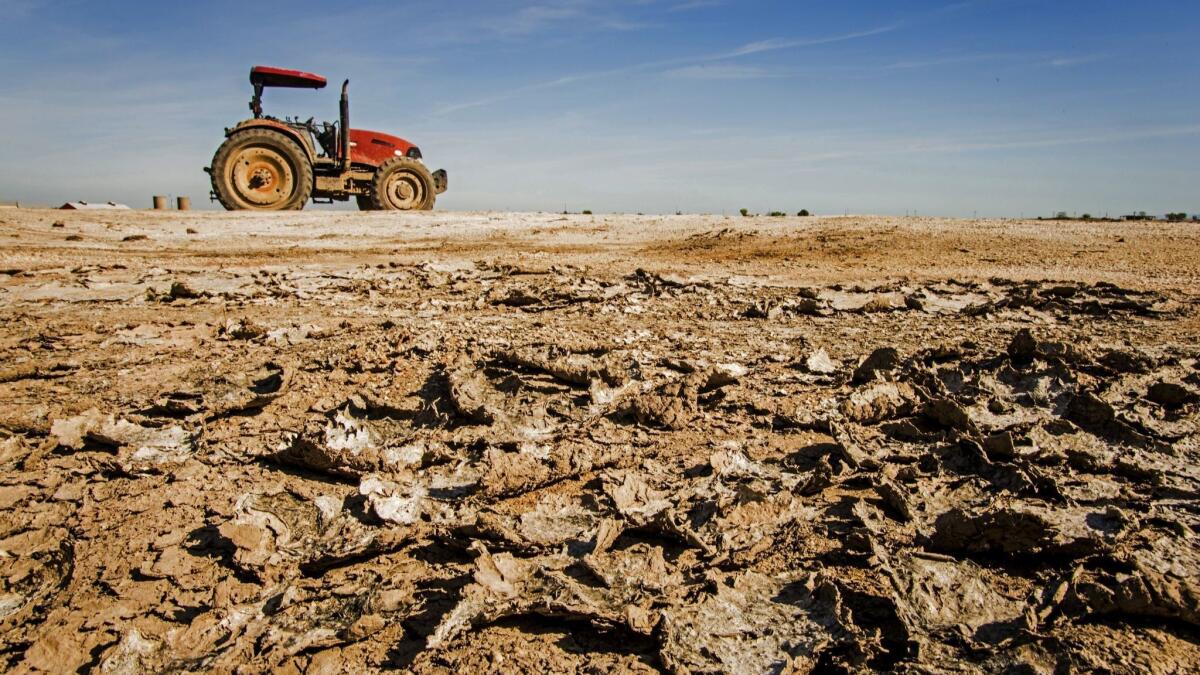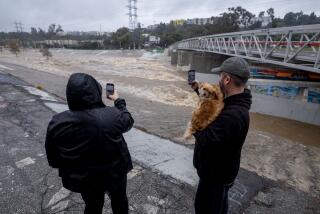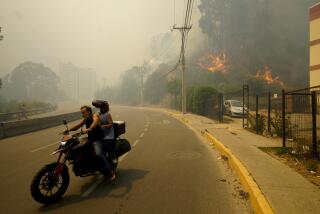In tree rings, signs that climate change started boosting drought risk long ago

Each spring, hikers flock to Figueroa Mountain, 30 miles northwest of Santa Barbara, to revel in the colorful displays of California poppies and purple lupine. But it’s the gnarled oaks of the rolling foothills that draw scientists.
Blue oaks can live for centuries, recording the history of the local climate in their wood. Now these trees and thousands of others around the world are helping researchers answer a difficult question: Has climate change amplified the risk of drought?
The answer, according to a study published Wednesday in the journal Nature, is yes.
By comparing projections from climate models to records of drought patterns inscribed in tree rings, scientists have detected what may be the fingerprint of greenhouse gases as far back as the early 1900s.
“There’s a kind of remarkable overlap between what the models say should have happened and what tree rings say actually did happen,” said Kate Marvel, a climate scientist at Columbia University and a lead author of the study.
Some researchers aren’t yet convinced that the results show a clear human influence on past drought trends. But the findings do suggest that climate models are on the right track when it comes to forecasting how climate change will impact key elements of the water cycle.
“Fundamentally, the question we were asking was, ‘Does the real world look like our model predictions?’ And it does,” said coauthor Ben Cook, a climate scientist at NASA’s Goddard Institute for Space Studies.
If true, the western United States will likely be in for more severe changes in the future, experts said.

By now, there’s ample evidence to show that global warming leads to rising seas and more powerful storms. But scientists have had a tougher time picking out the effects on precipitation, which should increase in some places and decrease in others.
Part of the problem is that the changes driven by humanity’s production of greenhouse gases usually get swamped by the tremendous natural variability of the climate system, particularly when studying the history of a specific region.
So Marvel and her colleagues took a different approach. They used climate models to identify the geographic pattern of drought induced by warming from greenhouse gases — in other words, its “fingerprint.”
For instance, while a natural phenomenon such as El Niño brings drought to one part of the world (like Australia), it brings rain to others (the American Southwest and Mexico). Greenhouse gases, on the other hand, promote drought in both places, as well as in the Mediterranean.
Scientists can measure drought in different ways, and in this case, the researchers focused on soil moisture, which is “a good variable to look at,” said Justin Sheffield, a hydroclimatologist at the University of Southampton in Britain, who was not involved in the study.
Soil moisture reflects a balance of rainfall and evaporation, and is a useful measure of drought’s effects on agriculture, water resources and ecosystems.
Once the researchers spotted the model fingerprint, they turned to troves of tree ring data to see if they could find it in the real world.

The thickness of a tree’s annual rings gives scientists clues about the growing conditions it experienced over time, and it’s particularly useful for reconstructing a record of soil moisture, Cook said.
“The one thing that matters more than anything else for most trees is water,” he said.
Over the last few decades, scientists led by Edward Cook — a scientist at Columbia and Ben Cook’s father — have compiled tree ring records from around the world into detailed “atlases” of drought. The atlases cover Europe, North America, Mexico, Australia, New Zealand and parts of Asia, and they stretch back hundreds or thousands of years.
When Marvel and her colleagues looked through the drought atlases, they were surprised to see the pattern from the models showing up in tree ring data back in the early 1900s, when greenhouse gas levels were much lower than they are today.
“It does seem kind of crazy,” Marvel said. But by looking at a large area over a long period of time, even a small change becomes apparent, she said.
That doesn’t mean human actions caused historic droughts like the Dust Bowl, but they probably helped set the stage for a more extreme event, Cook said.

Other researchers said the study authors’ method can’t determine whether the soil moisture changes recorded in the tree ring data occurred because of an increase in greenhouse gases or because of natural causes — which are also included in the model simulations used to create the fingerprint. For instance, there’s evidence that the sun emitted slightly more energy over the first half of the 20th century, which also affected the climate.
“It cannot be ignored,” said Aiguo Dai, a climate scientist at the University at Albany in New York, who was not involved in the study.
Sheffield agreed that natural sources of climate variability could have influenced the results. As it stands, “they are not definitive,” he said.
Marvel acknowledged that it will take “more work to disentangle the relative importance” of human and natural factors. But she said the results do suggest greenhouse gas warming had some effect, even if other forces were at play.
By the middle of the 20th century, the greenhouse gas fingerprint disappeared from both the tree ring records and the climate models.
That could be because humans were emitting more than just carbon dioxide, the study authors said. Newly built coal-fired power plants, in particular, began pumping out pollutants like sulfate aerosols. These particles reflect more incoming sunlight, and actually caused global temperatures to dip in the 1950s and ’60s.
After that, many countries passed air pollution laws that caused aerosol emissions to level off by the 1980s. That’s when the researchers saw the greenhouse gas fingerprint reemerge in weather observations, including one record compiled by Dai, which provide a recent history of drought patterns.
The signal wasn’t strong enough to be statistically significant and it’s still not as obvious as it was in the early 1900s.
But “we actually see the models and observations being in really good agreement,” said Deepti Singh, a climate scientist at Washington State University in Vancouver, who was not involved in the study. And that “provides us more certainty in believing the projections for the future.”
Climate models predict that the effect of greenhouse gases will continue to become more pronounced and will increase the risk of drought in many regions by the middle of the century.
Worsening drought will have devastating effects on global food production, which uses the majority of the world’s water resources, Cook said. “Unless you deal with that, then some of these areas are going to experience very big problems in a drier future.”
The outlook for the U.S. is particularly worrying, Dai said.
California and the West experienced punishing droughts in recent years, but natural climate variations and aerosol emissions may have prevented conditions from being even drier, he said.
“I don’t think the situation in the Southwest U.S. will improve anytime soon.”








